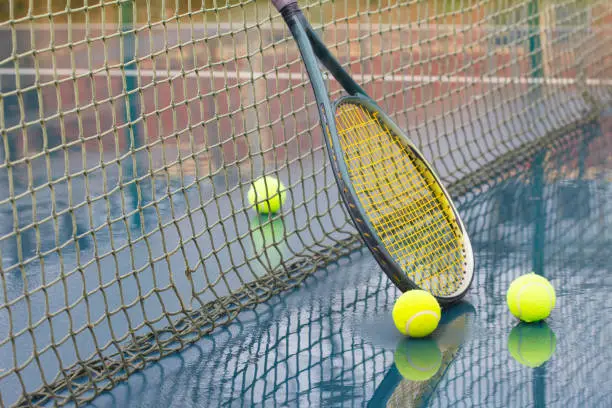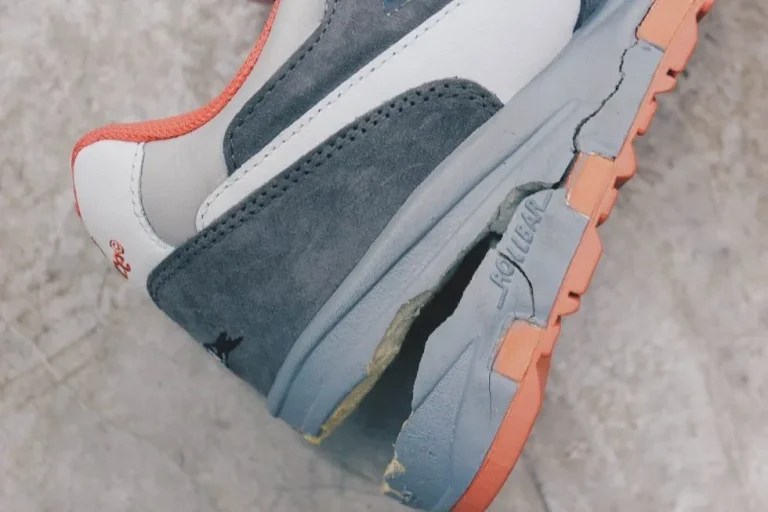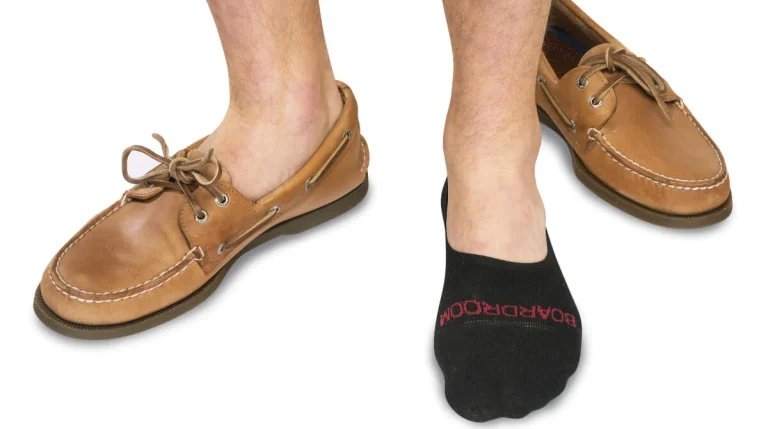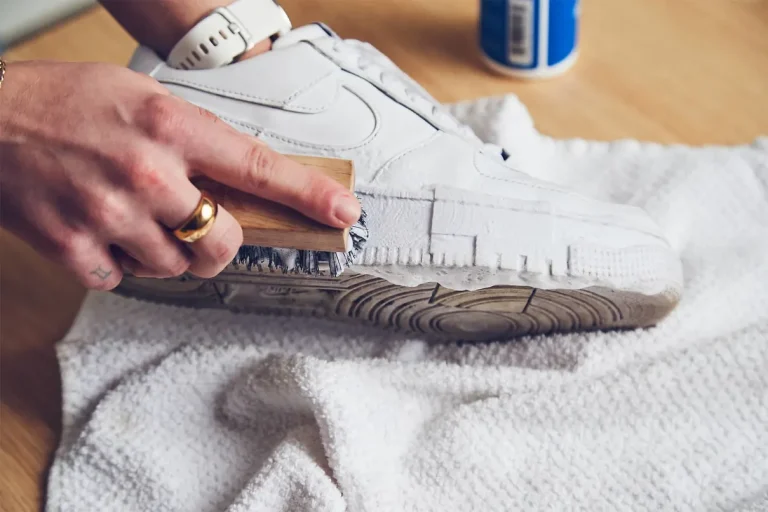Can You Play Tennis In The Rain? Expert Advice
Playing tennis in the rain is a topic that sparks debate among tennis enthusiasts. Many wonder if it’s feasible or even safe to play the sport in wet conditions. In this blog post, we will explore the pros and cons of play tennis in the rain, helping you make an informed decision about whether to grab your racket or stay indoors.
The purpose of this blog post is to examine the advantages and disadvantages of playing tennis in the rain, providing you with a comprehensive understanding of the potential risks and benefits involved.
Can You Play Tennis on a Wet Court?
Yes, you can play tennis on a wet court, but it is not ideal. Playing on a wet court can be challenging and potentially dangerous. The surface becomes slippery, making it difficult to move and increasing the risk of injuries. Additionally, the ball may not bounce properly on a wet court, affecting the overall gameplay. It is generally recommended to wait for the court to dry before playing to ensure a safer and more enjoyable experience.
Can you play tennis on wet tennis courts?
Yes, you can play tennis on wet tennis courts, but it is not ideal. Wet courts can be slippery, which increases the risk of injuries. The ball may also not bounce as predictably on a wet surface. It is generally recommended to wait for the court to dry before playing to ensure a safer and more enjoyable experience.
If you do decide to play on a wet court, take extra precautions, such as wearing appropriate footwear with good traction and adjusting your shots for the conditions.
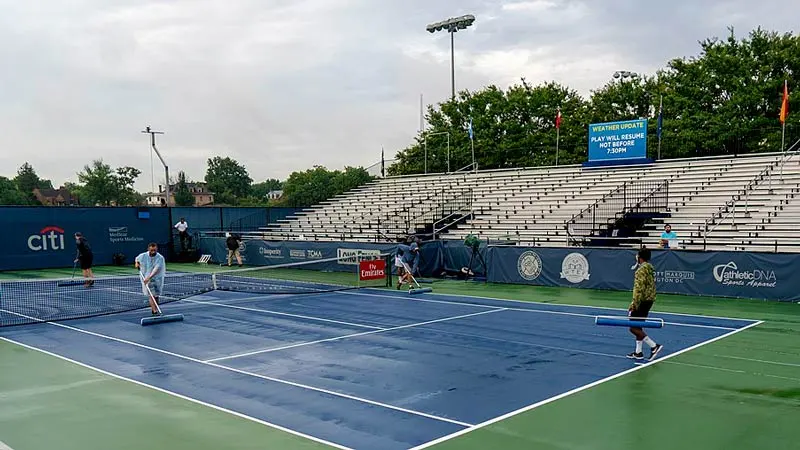
Tips for Playing Tennis in Rain
Some tips for play tennis in rain are listed below:
Wear appropriate clothing
Opt for waterproof or water-resistant clothing to keep yourself dry during the game. Consider wearing a hat or visor to shield your face from raindrops.
Choose the right footwear
Use tennis shoes with good traction to prevent slipping on the wet court. Some shoes have specific features designed for playing in wet conditions.
Adjust your grip
A wet racket handle can become slippery, so consider using an overgrip or towel to improve your grip. Experiment with different grips to find one that works best for you in wet conditions.
Modify your shots
Due to the wet court, the ball may not bounce as high or as predictably. Adjust your shots accordingly, using more topspin to keep the ball low and increase control.
Stay balanced
Maintain a lower center of gravity and be mindful of your footing to avoid slipping. Take shorter steps and be prepared to change direction quickly.
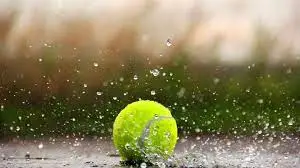
Remember, safety should always be a priority. If the rain becomes too heavy or the court becomes unsafe, it’s best to stop playing and wait for better conditions.
Related To: Best Tennis Shoes For Metatarsalgia : (Ball of Foot Pain)
Related To: Angriest Tennis Players: Of All Time
How to Avoid Injuries When Playing Tennis in the Rain
tips for avoiding injuries when play tennis in the rain. However, I can offer you some general advice:
Warm up properly
Prior to playing, perform a thorough warm-up routine to prepare your muscles and joints for the game. Focus on dynamic stretches and movements to increase blood flow and flexibility.
Use proper footwear
Wear tennis shoes with good traction and grip to minimize the risk of slipping on the wet court. Consider shoes specifically designed for wet conditions.
Slow down your movements
The wet court can be slippery, so it’s important to slow down your movements and be more cautious. Take smaller steps and avoid sudden changes in direction to maintain better balance.
Adjust your shots
Due to the wet conditions, the ball may not bounce as high or as predictably. Adapt your shots accordingly, using more control and precision rather than relying on power.
Be mindful of your surroundings
Pay attention to your surroundings, including any puddles or slippery areas on the court. Avoid those areas to reduce the risk of slipping and potential injuries.
Stay hydrated
Even though it’s raining, it’s still important to stay hydrated. Drink water regularly to maintain proper hydration levels during the game.
Take breaks if needed
If the rain becomes too heavy or the court becomes unsafe, don’t hesitate to take breaks or pause the game until conditions improve. Your safety should always be a priority.
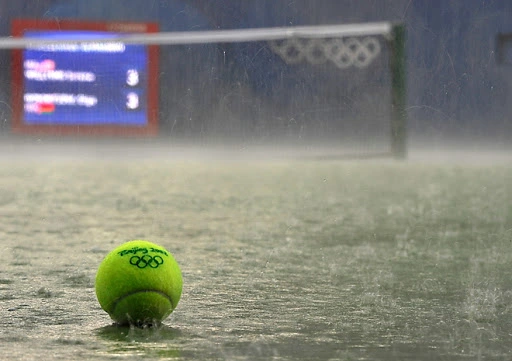
Remember, these are general tips, and it’s always a good idea to consult with a tennis coach or medical professional for more specific advice tailored to your individual needs and circumstances.
Cons of Playing Tennis in the Rain
Cons of Playing Tennis in the Rain:
Increased Risk of Injury
Playing tennis on a wet court can be risky due to the slippery surface. There is a higher chance of slipping and falling, which can lead to injuries such as sprains, strains, or even fractures. The wet conditions make it more challenging to maintain stability and balance during quick movements on the court.
Equipment Damage
Rain can damage tennis equipment, including rackets and balls. The moisture can cause the strings of the racket to become loose or even break, affecting the player’s performance. Wet tennis balls can become heavy and lose their bounce, making it difficult to play with consistency. Additionally, water can seep into the racket’s handle, potentially causing damage over time.
Limited Visibility and Comfort
Playing tennis in the rain can affect visibility, making it harder to track the ball accurately. Raindrops on glasses or the constant need to wipe off water from the face can be distracting. Wet clothes and shoes can also cause discomfort, leading to a decrease in focus and overall enjoyment of the game.
Challenging Playing Conditions
Wet conditions can alter the dynamics of the game. The ball may skid or bounce unpredictably, making it harder to execute shots with precision. Footwork can become more challenging due to reduced traction, affecting the player’s ability to move quickly and change directions effectively.
Potential Health Risks
Playing in the rain exposes players to cold and damp conditions, which can increase the risk of catching a cold or developing other health issues. Prolonged exposure to wet and cold weather can also lead to discomfort and decreased performance on the court.
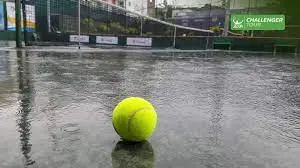
It’s important to consider these cons and prioritize your safety and well-being when deciding whether to play tennis on a wet court.
Conclusion
Yes, you can play tennis in the rain, but it is important to consider the conditions and take necessary precautions. Playing on a wet court can be challenging and potentially dangerous due to increased slipperiness. However, if you choose to play in the rain, make sure to wear appropriate clothing and footwear, adjust your shots for the wet conditions, and be mindful of your movements to avoid injuries. It is always recommended to prioritize safety and assess the court conditions before deciding to play in the rain.
Frequently Asked Questions
Latest Post

